4.16 oz E. Ruhling & Co. Virginia City, Gold Hill, or Hamilton, Nevada. Silver assay ingot
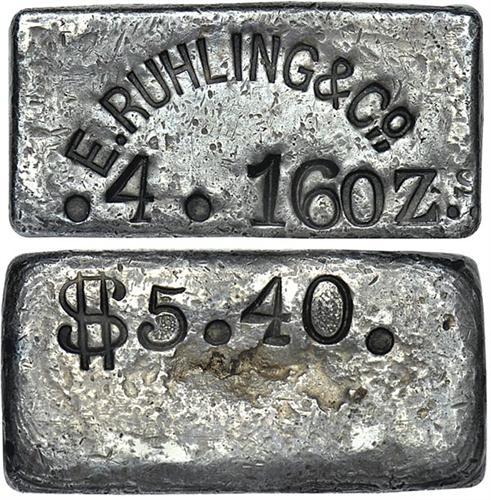
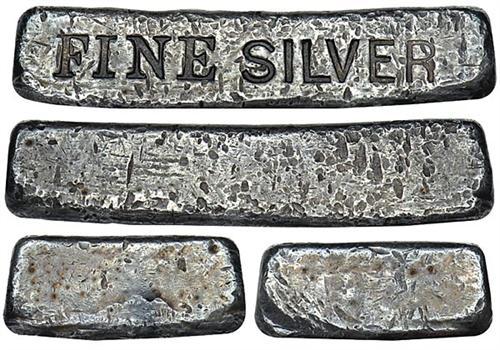
Overall appearance of Very Fine. Medium silver gray color. Surfaces rough in places, smoother where the piece has been handled. An interesting ingot. The ethnic seems to be a logotype but the remainder of the inscriptions seems accomplished by individual punches. The bar’s weight and dollar value are noted but its content is stated only as fine silver. The ingot would appear to violate some of the requirements for a “genuine” ingot demanded by critics, yet unless Mr. Ford and Mr. Franklin were older than we think they were, the bar’s first auction appearance predates them by several decades.
In the absence of an OIR stamp the ingot can be dated 1861-64 in Virginia City, 1868 or 1873 – 1884 in Virginia City, Gold Hill, or Hamilton, Nevada. Given the ethnic style it is unlikely that Ruhling made this bar 1858-61 in San Francisco yet the limited use of logotypes, the unhelpful “Fine Silver” description, and the uncertainty about the residual content of the ingot mark it as the product of a novice operator.
- Face: E.RUHLING & Co. / .4.16OZ.
- Back: $5.40.
- Top side: blank.
- Bottom side: FINE SILVER.
- Left side: blank.
- Right side: blank.
- Dimensions: 49.5 x 24.9 x 11.2 mm.
- Current weight: 129.8 gms.
From the John J. Ford, Jr. Collection
Provenance: Ex George F. Ulex Collection (Lyman Low, July 8, 1902, lot 535), Garrett Collection (Bowers & Ruddy, March 25, 1981, lot 1945). Mr. Ford did not make up informational cards for every ingot in his collection, the present piece being an example.
[10/2007] https://auctions.stacksbowers.com/lots/view/3-AV6PF/e-ruhling-co-virginia-city-gold-hill-or-hamilton-nevada-silver-assay-ingot ($25,300)
Presenting a silver assay ingot from Ruhling & Co., with origins in Virginia City, Gold Hill, or Hamilton, Nevada. This piece boasts an overall appearance graded as Very Fine, exhibiting a medium silver gray color. While some surfaces display roughness, indicative of its age and handling, smoother areas hint at its history of use.
Notable features include inscriptions rendered in what appears to be a logotype while the remaining inscriptions seem to have been made by individual punches. Although the bar’s weight and dollar value are clearly noted, its content is simply stated as fine silver, lacking further specification.
Absent an OIR stamp, dating places the ingot within the periods of 1861-64 in Virginia City, or 1868 or 1873-1884 in Virginia City, Gold Hill, or Hamilton, Nevada.
With dimensions measuring 49.5 x 24.9 x 11.2 mm and a current weight of 129.8 gms, this piece offers a tangible connection to the historic silver industry of the American West.
From the esteemed John J. Ford, Jr. Collection, this ingot’s provenance includes prior ownership in the George F. Ulex Collection (Lyman Low, July 8, 1902, lot 535), followed by inclusion in the Garrett Collection (Bowers & Ruddy, March 25, 1981, lot 1945). Please note that not all ingots in Mr. Ford’s collection have accompanying informational cards, with the present piece serving as an example.
[03/2024] https://bidnow.vegascoindealer.com/Listing/Details/223598/Rare-E-Ruhling-Co-Virginia-City-Gold-Hill-or-Hamilton-Nevada-Silver-Ingot ($34,111)
25.70 oz E. Ruhling & Co. Probably Virginia City, Nevada. Silver and gold assay ingot number 6932
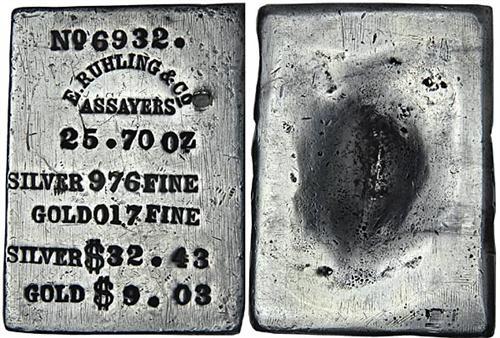
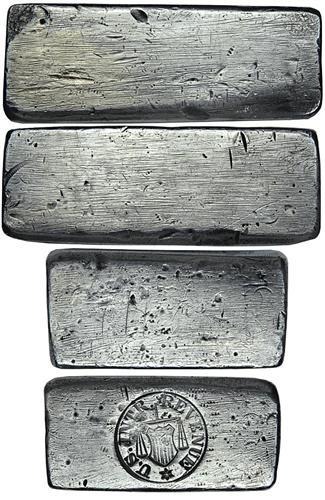
Overall appearance of nice Very Fine. Pale silver in color on all sides, the piece has been cleaned. A well made ingot and most likely a commercial bar rather than a presentation or souvenir ingot. Unlike the previous, this ingot has the look of a professionally made product executed by a firm experienced in the trade. All sides flat and fairly smooth but not polished and the edges left essentially as they came from the ingot mold. Deep cooling depression on the back. Some marks, scratches on the inscribed face, one fairly serious dig to the right of the assayer’s logotype. Same ethnic, SILVER, GOLD logotype punches as on the bar to follow; FINE logotype possibly the same as on next. The Office of Internal Revenue punch on this bar shows all four of the diagnostics seen on the others in Mr. Ford’s collection.
- Face: No. 6932. / E.RUHLING & Co. ASSAYERS / 25.70 Oz. / SILVER 976 FINE / GOLD 017 FINE / SILVER $32.43 / GOLD $9.03.
- Back: blank.
- Top side: OIR stamp.
- Bottom side: blank.
- Left side: blank.
- Right side: blank.
- Dimensions: 65.9 x 49.0 x 24.4 mm.
- Stated weight: 25.70 ozs.
From the John J. Ford, Jr. Collection
Provenance: Ex Heritage’s sale of February 2, 1989, lot 2998; the same bar was illustrated in Columbus Industries’ (Fred Holabird) offering in November, 1999. First offered to Mr. Ford in November, 1987 by John Heleva of Cal National Coin Exchange for $6,000. Mr. Ford countered with $3,500. At the Heritage sale in 1989 Mr. Ford paid his agent (Tony Terranova) $3,410 for it.
[10/2007] https://auctions.stacksbowers.com/lots/view/3-AV6PL/e-ruhling-co-probably-virginia-city-nevada-silver-and-gold-assay-ingot-number-6932 ($25,300)
23.60 oz E. Ruhling & Co. Virginia City, Gold Hill, or Hamilton, Nevada. Silver and gold assay ingot number 9467
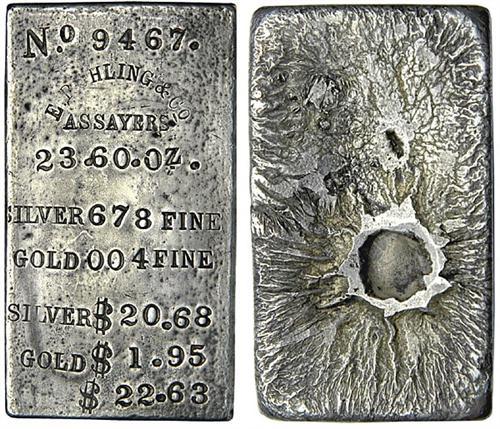
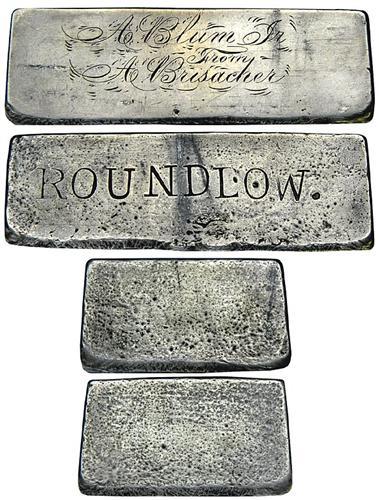
Overall appearance of Very Fine. A well made bar and an instructive contrast to the preceding. Face and sides finished and flat, edges squared, one long side polished to receive the presentation inscription (probably by the engraving shop), the other left as poured but stamped, nevertheless. Back very rough, left entirely as made with a crater like cooling depression. Same ethnic, SILVER, GOLD logotype punches as on the previous bar; FINE logotype possibly the same as on the preceding. The identities of A. Blum and A. Brisacher are unknown. “Roundlow” is likely the source of the silver that made the bar but whether it was the name of a mine, a small claim, or something else is also unknown to the cataloguer. Ruhling’s company made the massive $3,123.76 silver and gold bar for the benefit of the wounded survivors and families of the dead in the Franco-Prussian War, 1870.
- Face: No. 9467. / E.RUHLING & Co. ASSAYERS / 23.60 Oz. / SILVER 678 FINE / GOLD 004 FINE / SILVER $20.68 / GOLD $1.95 / $22.63.
- Back: blank.
- Top side: blank.
- Bottom side: blank.
- Left side: A. Blum Jr. / From / A. Brisacher [all in a neat script].
- Right side: ROUNDLOW.
- Dimensions: 74.9 x 42.6 x 24.4 mm.
- Stated weight: 23.60 ozs.
From the John J. Ford, Jr. Collection
Provenance: Bought from Gary Fitzgerald by Tony Terranova for Jon Hanson at the June, 1982 Long Beach convention. Said ex a Westchester County, N.Y. antiques auction. Ex Jon Hanson on August 14, 1997. Mr. Ford’s informational card with his pencil drawing of the bar accompanies the lot.
[10/2007] https://auctions.stacksbowers.com/lots/view/3-AV6PR/e-ruhling-co-virginia-city-gold-hill-or-hamilton-nevada-silver-and-gold-assay-ingot-number-9467 ($25,300)
[09/2017] https://www.icollector.com/Nevada-Virginia-City-Gold-Hill-or-Hamilton-E-Ruhling-Co-Gold-and-Silver-Ingot-22-63-VF_i27907322 ($14,100)
3.25 oz Ruhling & Co. Assayers. Virginia City , Nevada. $5.98 mixed metal ingot. EF-45.
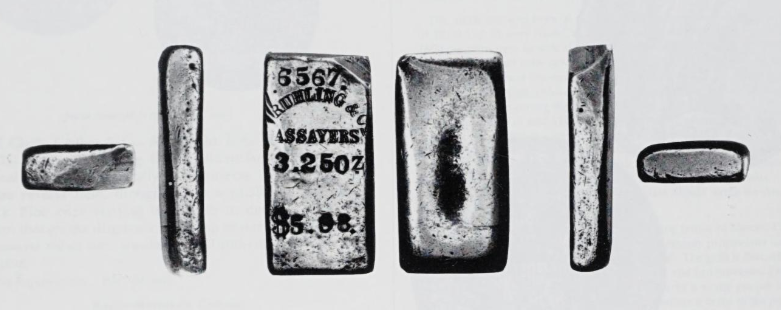
Cast impression stamped on one side with 6567 E. RUHLING & Co ASSAYERS 3.250z and value $5.98. Comer cut at top right when viewing the stamped side. Lightly worn from handling over the decades, but still a nice example. Exceedingly rare; the first handled.
It will be seen that although silver makes up most of the weight of this mixed-metal ingot, gold makes up most of the value. The term electrum is sometimes used to indicate a mixture of gold and silver.
It was reported in Langley’s San Francisco Directory, January 1858, Year of 1857 in Review:
Ed Ruhling was a native of Hamburg, Germany who became a naturalized citizen of the United States. According to Langley’s 1858 San Francisco Directory he was listed as being an assayer at the same address as Wass, Uznay 8c Warwick (the first-named partner having been associated with the earlier firm of Wass, Molitor & Co.).
In an 1861 lithograph, which featured prominent buildings in Virginia City, Nevada Territory, there is a drawing of E. Ruhling & Co.’s assay office. Ed went on to have a successful assaying and banking career in Nevada’s Comstock Lode with his partner H.V.S. McCullough. Their partnership lasted until March 31, 1871. E. Ruhling & Co.’s home office was located on B street in Virginia City, Nevada.
In the summer of 1868 they opened a branch office in Gold Hill by succeeding Van Wyck & Co.’s assay office. The firm also had a branch office in Hamilton City, Nevada.
On May 7, 1869, the Virginia Territorial Enterprise (a newspaper where Samuel L. Clemens, a.k.a. Mark Twain, had worked earlier in the decade) carried this account:
“A Piece Of The Last Spike: We were yesterday presented with a piece-about an ounce in weight-of the last spike-the silver spike of Nevada-by E. Ruhling 8c Co., the well-known assayers of this city. E. Ruhling 8c Co. had the order for making the silver spike, and it was under their supervision that it was manufactured. When the spike was made— drawn out from the bar which was moulded for the purpose— it was found to be much longer than necessary, and some four inches of the thick portion was cut off. As even the smallest portion of this last spike will for all time be much treasured, we will give its exact fineness, which is gold, 50; silver 942; value per ounce, $22.05. Those who may
hereafter manufacture bogus specimens of the “last spike” will do well to have the fineness in gold and silver correspond with the genuine. The only mark on the spike when it left this city was the stamp of E. Ruhling 8c Co. When brought back we understand that it will be beautifully polished and appropriately engraved, when it will be deposited in the State Cabinet at Carson City…”
On May 10, 1869, at Promontory Point in the Territory of Utah, a ceremony was conducted to unite the rails linking New York City with San Francisco. Now, the journey from coast to coast could be made in just eight days, a far cry from the months it had taken by the overland route two decades earlier.
The San Francisco newspaper Alta California, May 12, 1869, informed readers:
“Hon. F A. Tritle, from the State of Nevada, presented a silver spike on behalf of the citizens of Nevada, with the following remarks: ‘To the iron of the East and the gold of the West, Nevada adds her link of silver to span the continent and weld the irons.’…”
Soon thereafter, the ceremonial sliver of silver made its way back to Nevada. The Virginia Territorial Enterprise, May 23, 1869, told the story:
“The Last Spike: One of the last spikes-the silver spike of Nevada-is to be seen in the show window of Nye 8c Co., jeweler, in this city. It has been somewhat remodeled since being drawn from the track, and has been beautifully polished. It is placed in a neat case fashioned to fit it, and bears the following inscription. ‘To Leland Stanford, President of the Central Pacific Railroad. To the iron of the East and die gold of the West, Nevada adds her silver link to span the continent and wed the two oceans.’ ”
Thus, Ed Ruling, whose ingot is offered in the present lot, played a small part in one of the most significant transportation events in American history.
Later in life, Ruhling worked as an assayer for the San Francisco branch mint.
Thanks to Dan Owens for furnishing the preceding historical information.
[11/1998] https://archive.org/details/morganleckarcolu1998bowe/page/274/
